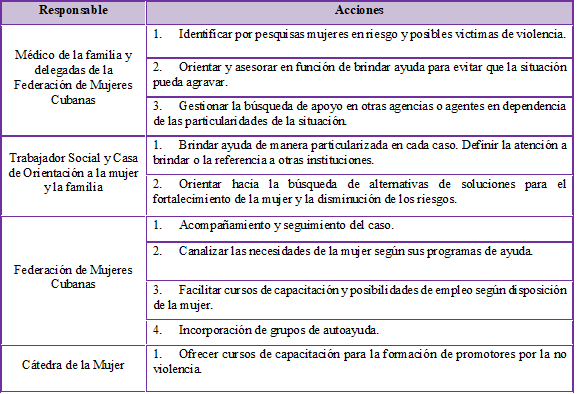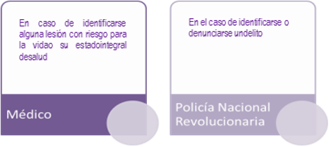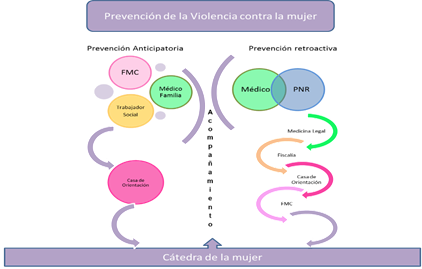Meu SciELO
Serviços Personalizados
Artigo
Indicadores
-
 Citado por SciELO
Citado por SciELO
Links relacionados
-
 Similares em
SciELO
Similares em
SciELO
Compartilhar
EduSol
versão On-line ISSN 1729-8091
EduSol vol.23 no.83 Guantánamo abr.-jun. 2023 Epub 03-Maio-2023
Original article
Critical Path Protocol for the Prevention of Violence against Women
1Universidad de Guantánamo, Cuba.
The proposal is the result of a research conducted by the Women's Chair of the University of Guantánamo that provides a critical path protocol with the objective of contributing to the preparation of agencies and social agents for the prevention of violence against women. It was developed in the period of 2018-2022 and takes a sample of 7 social agencies, represented by 62 social agents out of a population of 480 agents. It relied on methods such as theoretical, empirical and mathematical-statistical methods. The results were validated through methodological triangulation, making it possible to demonstrate their novelty, relevance and feasibility.
Key words: Violence against women; Prevention; Agencies and social agents; Critical route
Introduction
Violence against women is not a recent problem; however, its understanding as a social problem goes beyond the intimate-private space. It is complex when it has remained invisible due to its naturalization as part of the patriarchal culture for centuries. For this reason, it is a shocking reality that occurs in communities, families, schools and society in general.
In this sense, the university has the duty to transform itself in order to respond to the social demands of the society in which it is inserted (Horruitiner, 2006, p.5). In view of this, it is essential to recognize the joint work of agencies and social agents with the support of universities, in order to prevent violence against women. It is also valid to recognize the theoretical and methodological shortcomings that are evident in this working group. For this reason, the following scientific problem is stated: How to contribute to the prevention of violence against women in Guantánamo?
For which it is conceived in a first moment, the establishment of a dynamic and systematic relationship of the agencies and social agents with the Women's Chair as the leading agency representing the university. From this premise, a critical path protocol is elaborated as a methodological guide for the work of the agencies and social agents in terms of the prevention of violence against women. The objective of this protocol is to prepare agencies and social agents for the prevention of violence against women.
The sample consisted of 7 social agencies (Prosecutor's Office, Federation of Cuban Women, House of Attention to Women and the Family, Legal Medicine, Polyclinic, Ministry of Labor and Social Security, the National Revolutionary Police), representing 62 agents out of a population of 480 social agents.
For the development of this research, different theoretical methods were applied (historical-logical, analytical-synthetic, inductive-deductive); empirical methods (observation, interview, questionnaire, documentary analysis, socialization workshops and experience reports); mathematical-statistical method (percentage analysis).
Development
Prevention in Cuba is one of the most important objectives of education. It has a philosophical, sociological, medical, psychological, pedagogical and legal foundation that impacts the reality of educational quality (Díaz, 2011).
The word prevention, from its meaning, is a complex term, generating a high degree of confusion when defining its meaning. The multidimensionality of the concept has allowed it to be used in dissimilar fields of action and knowledge. This means that, although there is a wide production of conceptualizations, there is no unifying consensus of definitions.
Thus, after systematizing the category of prevention, the authors define the prevention of violence against women as: the set of integrated educational actions, of an anticipatory, retroactive and bidirectional nature, in the socio-political, economic, legal and psychological order, developed by social agencies and agents, in order to prevent or counteract damage, harm or deterioration to women and their social condition.
Anticipatory refers to the capacity of foresight that the agency or social agent that carries out preventive actions must possess; and retroactive has to do with the capacity to diminish the effects caused by the problem (violence against women). It is oriented in a bidirectional manner, both for the victim and for the aggressor who causes it, in order to reduce the risk of its occurrence.
In relation to the above, it is important to consider several elements that constitute theoretical foundations for the approach to the prevention of violence against women. Among them is the establishment of three levels of prevention and three types of prevention (Fuentes Avila, Vasallo Barrueta, et al., 2005):
Higher or societal level: these are actions aimed at the solution of important political, economic and social problems that influence the development of society and consequently with the elevation of the level and quality of life of the population.
Middle level or of the agents of socialization: refers to actions that, through policies, laws, regulations and other provisions, are applied with the objective of contributing to the adequate development of the different agents of socialization.
Individual level: refers to actions aimed at specific individuals and whose objective is to contribute to the adequate development and social adjustment of the person.
For an effective functioning of the three levels of prevention, actions directed through types of prevention must be conceived, which, from the scientific literature, are conceptualized as Primary Prevention, Secondary Prevention and Tertiary Prevention.
Prevención primaria:
Its objective is to reduce the incidence of violence against women, as well as the reduction and/or elimination of the frequency of new cases over a period of time. Its mission is to reduce risks in a population through socio-political changes.
Secondary prevention: It is the one that tries to discover and eliminate the concrete difficulty, so that it does not consolidate. It is carried out through early diagnosis of the manifestations of violence against women and immediate attention with effective treatment. It works with affected individuals or acts for the early detection of possible high-risk cases, i.e. it is oriented to generate changes.
Tertiary prevention: Its function is to hold back or delay the evolution of violence against women, so as to contribute to the reduction of its consequences despite the persistence of the initial effect. Its purpose is the rehabilitation of subjects, with the objective of minimizing the effects.
An effective performance of preventive work requires the articulation of these three types of prevention, i.e. any strategy or program should be considered addressing the causes that appear at these levels, organizing actions aimed at intervening from each of them contextualized to violence against women.
The critical route constitutes a management method to identify the most immediate educational tasks and actions to be carried out by agencies and social agents, in order to reduce the time and costs used for the prevention of violence against women. This is materialized through educational actions, so that they are carried out in the appropriate order and time with certain flexibility and in accordance with what is legislated.
Agencies and social agents. Characteristics and functions.
According to Blanco Pérez, A. 2002), in society there are different "agencies" and "agents" to materialize the process of socio-individualization. These agencies and agents are: the family, friends, the community, different groups, the media, the school. In each of these agencies man is educated - is formed - socially and individually by different ways. Therefore, they are considered the basis for the analysis of the personalized processes that occur within socialization as a macro-process, based on its magnitude and scope, and the prevention of violence against women is no exception.
For the creation of the critical path, the following are proposed:
The women's chair: mediating agency for the management of social agencies and agents, through the management of theoretical and methodological knowledge to articulate actions to prevent violence against women as part of university outreach.
Federation of Cuban Women: mass organization that constitutes a support agency that transversalizes the work of attention to women. It is the representative of women and their rights in society. Among its functions are, among others: attention to violence and coordination of the group for the prevention and attention to domestic violence in which several agencies and organizations participate.
House of orientation for women and the family: the main objective of this agency is to help improve the quality of the work of the Federation of Cuban Women by preparing activists and diversifying options for courses, training and consultations for groups of different ages and interests. Among its functions are: to promote the work of the Federation of Cuban Women; to provide guidance and/or specialized attention to those individuals or families who come to it requesting help or who are detected in the daily work of the communities.
Office of the Attorney General of the Republic: agency in charge of verifying compliance with the laws and regulations on violence. As well as participating in crime prevention tasks and in the fight against all manifestations of crime or antisocial behavior.
National Revolutionary Police: it is part of the general directorate of the Ministry of the Interior. As a social agency, its main function is to act proactively, in a prophylactic, preventive and communitarian manner on persons of police interest in order to guarantee public order and citizen tranquility.
Social workers: social agents of vital importance in community work. Among their functions are to characterize, diagnose and intervene with individuals, families, groups and communities, based on the following principles: to know and transform, to act on the causes, action focused on people and not on the problems, to act taking into account the social context and self-transformation from the potentialities. In addition, the social worker must carry out participatory processes at different levels, such as characterizing, diagnosing, developing action systems, as well as evaluating and following up.
Physicians: are those agents in charge of prescribing and administering adequate treatment following a diagnosis of injuries or sequelae as a result of maltreatment. In addition, they are those who guide and advise patients and their families on the conduct to follow for the achievement of their general health wellbeing.
Forensic Medicine: Agency responsible for qualifying the injuries and determining whether they constitute a crime and guiding the way to follow up on the case.
Critical path process
For the formation of a critical path it is essential to determine its objectives and purpose. For this, it starts from the management of the university from the women's chair, in order to methodologically prepare the agencies and social agents for the prevention of violence against women. In this sense, some suggestions are offered as alternatives, based on the systematization of experiences in the work of these agencies and social agents in this direction.
For the researcher Montsaret Sagot, "the critical route is a process that is built from the sequence of decisions taken and actions executed by women affected by domestic violence and the answers found in their search for solutions". (Sagot & Carcedo, 2000, p. 81). In this case, the scope of violence transcends the family sphere as it is adjusted to all violence of which women may be victims.
With this route, women, through the social response provided by social agencies and agents, must satisfy their need for protection and help in the face of violence, which in turn constitutes a determining part of the critical route. This describes the decisions and actions taken by women and the responses found, both in the family and in the institutional sphere. The latter is the focus of the proposal of the route to follow, since it takes into consideration the agencies and social agents as the ones in charge of providing a response in accordance with the regulations established for the prevention of violence against women.
For the route to work, it is important that all the factors are interrelated in order to influence the subjectivity of women in their decision to initiate and continue on a path of seeking help and solutions. Failure to follow a critical path is the most common cause of abandonment of care services by women victims of violence.
Given the number of factors involved, the critical path is a complex, non-linear process that involves advances and setbacks. This is why the proposal shown is only an option and not a pre-established plan, as it is subject to the specific situation of violence. It is therefore a process of empowerment of women, in which agencies and social agents provide help, guidance, support, information and accompaniment as a guarantee of their rights.
As a premise, it is important to consider the understanding of the cycle of violence described by (Walker, 2012). In this order, the first step of the route is to recognize violence in order to break the silence and seek help. When prevention is anticipatory, the route to follow will be the one illustrated in Table 1.
On the other hand, retroactive prevention expresses the capacity to diminish the effects caused by violence against women. If an injury is identified that endangers the physical integrity or violates the rights of the woman, the route to follow will be through the entries shown in Figure 1 and Table 2.
Figure 1 shows the entry pathways to be followed for the development of the critical path. This gives way to the different actions to be developed by each agency and social agent involved in the process of preventing violence against women.
According to the protocol designed, the agencies and agents in charge of the first contact will identify the procedure to follow, so the itinerary of the route is not linear depending on the particularities of the case. Simultaneously, several actions will be taking place and impacting several agencies or agents along the route.
For this purpose, it is essential to provide the necessary accompaniment and follow-up to the case according to the criteria contained in the critical route of general care in accordance with what has been established. This means that there are actions that must be essential throughout the development of the critical route, which transversalize it: accompaniment for the achievement of emotional stability in the solution of the problematic situation.
Other actions parallel to the critical path:
- The identification of critical situations from the promotion of the social perception of violence.
- Coordinate with other entities or companies to promote the opening of positions and priority hiring of women who have been victims of violence.
Use the information and communication media to disseminate the service of each agency and the critical route service (radio, television, newspapers, orientation brochures and others that can facilitate the process). In this sense, we propose the graphic representation of the critical route to be followed by the different agencies and social agents according to their social mandate as shown in Figure 2.
This route expresses the relations of subordination and coordination established between the different agencies and social agents, where the women's chair of the University of Guantánamo provides accompaniment in terms of prevention.
lll. Methodological suggestions for the work of agencies and social agents in the prevention of violence against women.
Although it is a reality that the manifestations of violence against women are diverse, the attention, although particularized, must comply with a pattern that guides and allows providing support to the victims. Regardless of the fact that each of the agencies and social agents has a specific mission, it is important that these victims find the necessary support to face the risk of breaking the silence, assuming, within their professional role, the prevention of violence against women. In this sense, some suggestions are proposed below with the assumption of ethical premises such as privacy and confidentiality as a guarantee of success of any of the actions.
Actions:
Constantly prepare for the confrontation of violence from the different areas of action.
Plan aspects related to the prevention and care of violence against women and related topics in training courses.
Personal management of knowledge related to the prevention and care of violence against women and collaborate in the training of other agencies and agents.
Strengthen multidisciplinary victim assistance teams and diversify them throughout the municipalities and communities.
Promote workshops for the exchange of experiences with other professionals (institutions, agencies and agents) that can contribute to addressing the problem.
Link with community activists to strengthen the institutionalized work of agencies and agents.
Create formal alliances with the media to support their work in favor of prevention.
To link with the university as a knowledge-generating center, so that they can be nourished with updated information on the subject; as well as to obtain access to professional improvement in the field of science.
Conclusions
The actions proposed in the critical path protocol are in line with the definition of prevention of violence against women. In this sense, the value of the critical route and the logic of articulation between the actions, supported by their coherence and objectivity, are highlighted. It was evaluated as appropriate for the Guantanamo context so that not only victims and aggressors are helped, but also to contribute to the preparation of agencies and social agents to provide support.
Referencias bibliográficas
Blanco Pérez, A. (2002). Introducción a la sociología de la educación. Pueblo y Educación. https://isbn.cloud/9789591309310/introduccion-a-la-sociologia-de-la-educacion/ [ Links ]
Díaz, N. (2011). Estrategia de prevención educativa desde la escuela primaria de zona rural del municipio San Antonio del Sur (Tesis de Doctorado). Universidad de Ciencias Pedagógicas. «Enrique José Varona». [ Links ]
Fuentes Avila, M., Vasallo Barrueta, N., Alvarez Ledesma, L., & Pañellas Álvarez, D. (2005). Psicología social. Parte 3. Selección de lecturas (1.a ed.). Empresa Editorial Poligráfica Félix Varela. https://isbn.cloud/9789592588325/psicologia-social-parte-3-seleccion-de-lecturas/ [ Links ]
Horruitiner, P. (2006). La Universidad cubana. El modelo de formación. Editorial Félix Varela. [ Links ]
Sagot, M. & Carcedo, A. (2000). Ruta Crítica de las Mujeres Afectadas por la Violencia Intrafamiliar en América Latina: Estudios de caso de 10 países. https://doi.org/10.13140/2.1.4019.8726 [ Links ]
Walker, L. (2012). El Síndrome de la mujer maltratada (3.a ed.). Desclée de Brower Editores. [ Links ]
Received: August 25, 2022; Accepted: January 06, 2023











 texto em
texto em 






